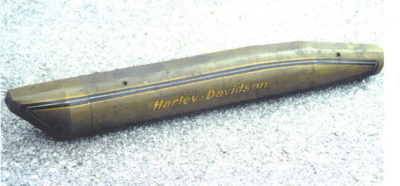How much should we rely on a bicycle catalog or it’s advertisements?
This is a beautiful rendering of a 1916 Indian motobike. This was the year Indian announced it was returning to the bicycle market and this was the introductory Motobike. Noticed the low-profile stance of the bike and that attractive slim cigar-tank neatly tucked between the narrow double bar frame. Also take notice of the shallow sides of the guards (fenders), the small apron on the bottom front fender...also there are no tank straps, and feast your eyes on that large Indian script displayed on the tank...have your eyeballs ever spotted this before? Seriously…have you ever seen this Indian?
I guess if it did exist, it might look something like this, but with tank straps?
Indian offered two motobike sizes; 21” & 19”. The different configurations, allows for the unique cigar-tank and the specifically designed end-caps that butt neatly behind the head tube of the desired frame size. These end caps are not reversible! Assuring one size does not fit all!
Much has been mentioned about the Columbia cigar tank...the Indian and the Columbia were Westfield built. If you wish to insert a Columbia tank between the double bars of a naked Indian…you’ll encounter a real challenge...it’s not easy without some modifications. The top and bottom frame tubes on the Columbia are longer in length than the Indian.
https://thecabe.com/forum/threads/trade-only-nos-columbia-cigar-tank.155123/
Initially the Indian motobike was specifically offered and sold to the young adult male? It wasn’t until after the company had changed its name from Hendee Mfg to Indian Mfg, that the board of directors also changed the bicycle direction, flipping the advertising messaging from the young male to the younger juvenile; this was to appeal to the siblings, inspiring them to be like their big brothers, who were zipping around town on their Indian Motorcycles.
Indian had developed a “retention strategy" from the cradle to the grave! Start them off young with bikes...developed their loyalty to the brand t as young men…and keep them as motorcycle enthusiasts until they’re too old to ride!
Harley Davidson had also tried this tactic, but later failed miserably! Arthur Davidson, HD Motor Company senior partner, decided to experiment with the introduction of a line of bicycles, featuring gorgeous paint, pinstripes and a proprietary chain ring. Davidson convinced his idea was a gem. But later said, his HD dealers, “just laughed at me,” “Who wants to pedal a bicycle if you can motor around on a motorcycle?” In the end, the experiment failed! The dealers eventually placed the bikes in the corner where they sat and collected dust. By 1922, the HD Motor Company had pulled out of the bicycle business.
Harley Davidson did offer a cigar-tank model version for its bicycle, offered to the dealers and was featured one year only.

Allow me to reprise my previous findings, every Indian motobike showcased on the covers of its catalog before 1924 featured the 19” model? Yet the catalog copy states that the 19” frame was an option. Any thoughts as to why the secondary bike is featured as the number one bike?
After change its messaging to focus in boys, in 1928 the catalog share both Motobike frames. But this time the tank model and the delivery bike are the same frame, and they're listed as 19" bikes (which makes sense since its now directed to a younger audience) Now I'm confused, because I always thought this particular frame geometry was the taller 21"frame? Am I being misled by the catalog images or copy?
What size is this tankless motobike model? Looks like the 19"
If I've confused you... joined the club! I'm a life member, having spent a great deal of time trying to get clarity...there's just too much to uncover!
Just how many Motobike frames did Indian offer each year? I'd like to think just two sizes, but I've been wrong before? Perhaps those collectors who are so lucky to own an Indian motobike could submit their frame size and which geometry design they have A or B ?


















